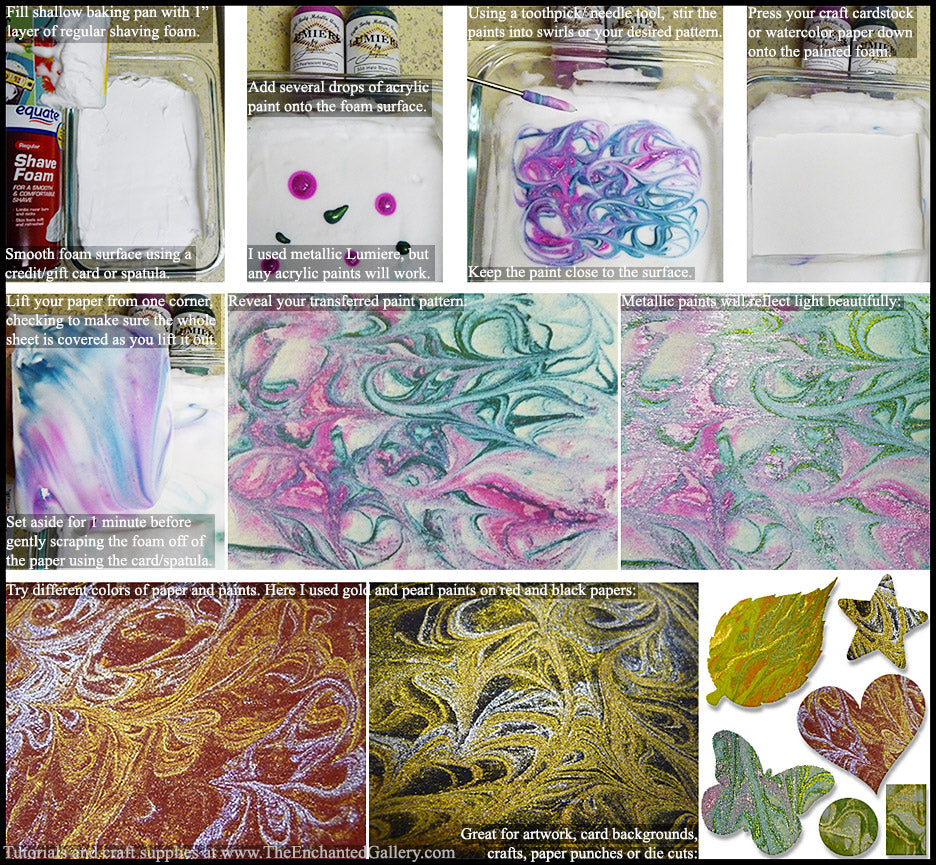Mixed Media Acrylic Marbling Swirl Techniques Tutorial
Easy methods for marbling and swirled paint effects: 1) Shaving cream acrylic paint transfers. 2) Using marbling inks floating on water for paper or fabric dipping. 3) Thick acrylic paint on canvas or wood swirled with stir stick or comb. 4) Thick acrylic paint on canvas or wood applied by pouring or dripping techniques. 5) Paint applied to a non-stick craft sheet, water misted and paper dipped into it. Compare the different types of acrylic paints, liquid acrylics and distress paints.
6) A similar effect can be made with dragging a hair comb or eraser marks over gel plates (mono printing plates such as a gelli plate / gel press). A new tutorial for this has been added to the bottom of this page.
6) A similar effect can be made with dragging a hair comb or eraser marks over gel plates (mono printing plates such as a gelli plate / gel press). A new tutorial for this has been added to the bottom of this page.

Shaving Cream Transfer Technique:
This method is ideal for any sturdy cardstock or watercolor paper using acrylic paint. It is very inexpensive, I used less than 10 cents worth of shaving cream in the photo tutorial below from my $1 can of Equate. Only buy regular foam (not gel or any kind with special moisturizers).


Water misted acrylic paints applied to a non-stick craft sheet to be picked up with heavy cardstock or watercolor papers:
Distress paint is the most popular product used in this method, but here I will explore all types of acrylic paint products from the cheapest craft acrylics, liquid acrylics, watered-down heavy acrylic paints and more.


I have seen several comments about distress paint being "just watered down acrylic" so I did some testing, and it plainly is not. Distress "Paint" is actually a hybrid between Ranger's ink products and a unique chalky opaque substance that lacks the typical acrylic paint binder. It is not the same as any of the acrylic paints I tried, not even heavily watered down paints or liquid acrylics. The binder that makes up "acrylic" is a glue-like substance, it creates a film with a bit of shine. You can literally peel acrylic paint off of a non-stick surface because of this binder. Distress paint lacks that thick glue-like shine, leaving a page decorated with it easily drawn on with pen or pencils. It also does not thin with water the same way acrylic does, the chalky opaque substance makes it less transparent than acrylic paints when diluted with water.


Using a comb, tooth pick or needle tool to create marbling patterns in thick applications of acrylic paints:
Because this method requires a thick enough layer of paint to be swirled, I prefer to use inexpensive craft acrylics.

This pattern is created by squirting out acrylic craft paints in stripes of alternating colors next to each other on a canvas. Use a hair comb to drag through the paint, waving the stroke with the comb as you go.
I recommend using a light body acrylic, not heavy or liquid, such as the inexpensive types in a bottle commonly found at Michaels/JoAnn craft stores. Apple Barrel and Deco Art brands have a nice semi-liquid light body (not too thick to swirl the paint, not too thin to instantly blend together) and average only 50 cents to $2 per 2oz bottles.
Step by step pictures and more projects made with this technique coming soon. Stay updated with what is new on this page on the "coloring tutorials" board on pinterest.
I recommend using a light body acrylic, not heavy or liquid, such as the inexpensive types in a bottle commonly found at Michaels/JoAnn craft stores. Apple Barrel and Deco Art brands have a nice semi-liquid light body (not too thick to swirl the paint, not too thin to instantly blend together) and average only 50 cents to $2 per 2oz bottles.
Step by step pictures and more projects made with this technique coming soon. Stay updated with what is new on this page on the "coloring tutorials" board on pinterest.

Pouring or dripping effects with acrylic paints for canvas or wood surfaces:
This method can be done with thinned acrylic paints by diluting with water or pouring mediums (such as Liquitex Pouring Medium, or Golden's Gac 800).
Paint pouring project images coming soon.

Marbling paper or fabric in water using special "marbling inks" that float on the water's surface:
There are many ways to marble paper on water, most of them include using powders in the water and coatings for papers that canbe expensive and complicated to set up. The method I tried here simply uses special formulated inks that are fast drying oil-based pigments that float on water and adhere to any dry surface you dip onto it.


Basics of monoprinting (a single print from a gel plate that has been coated with paint).



A fun thing to do with your marbled papers is to transfer images onto them from your favorite photographs or magazines.
Package tape can be used to easily and cheaply make small item transfers: Alternate method to create shiny image transfers using magazine images or toner (laser printer) prints with nothing but clear packaging tape and water!

Note: this page contains affiliate links. All product opinions are my own. I am committed to honest reviews showcasing both the pros and cons of each product. I have not received payment from any brand for a review. I earn a commission from sales made through this web page's clickable banners or links to Amazon, Arteza, Scrapbook, Jackson's or Blick Art Materials websites.
